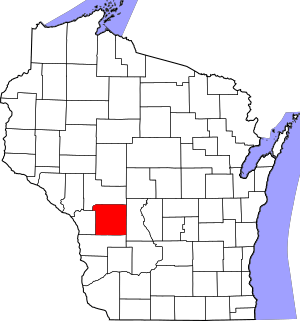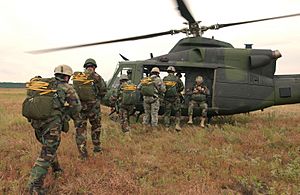Fort McCoy (Wisconsin) facts for kids
Quick facts for kids Fort McCoy
|
|
|---|---|
| Part of United States Army Reserve Command (USARC) | |
| Located near: Tomah, Wisconsin | |
| Coordinates | 44°00′35″N 90°41′00″W / 44.00972°N 90.68333°W |
| Site information | |
| Owner | United States Army |
| Condition | Active |
| Site history | |
| Built | 1909 |
| Built by | Major General Robert Bruce McCoy |
| Garrison information | |
| Occupants | United States Army, 86th Training Division, 88th Regional Support Command, 181st Infantry Brigade, 426th Regiment (Regional Training Institute) & Wisconsin Military Academy, Wisconsin State Patrol, Fort McCoy Police Department, Equipment Concentration Site 67, Maneuver Area Training Equipment Site, NCO Academy |
|
Fort McCoy
|
||
|---|---|---|
 |
||
|
||
 |
||
| Country | United States | |
| State | Wisconsin | |
| County | Monroe County | |
| Area | ||
| • Total | 90 sq mi (240 km2) | |
| Elevation | 873 ft (266 m) | |
| Population | ||
| • Total | 2,215 | |
| • Density | 23.9/sq mi (9.23/km2) | |
| Time zone | UTC−6 (Central (CST)) | |
| • Summer (DST) | UTC−5 (Central (CDT)) | |
| ZIP Code |
54656
|
|
| Area code(s) | 608 | |
Fort McCoy is a large training base for the United States Army Reserve in Wisconsin. It covers about 60,000 acres of land. It is located between the towns of Sparta and Tomah in Monroe County. Since it was created in 1909, Fort McCoy has mainly been used to train soldiers. Parts of the base are also used by the Wisconsin State Patrol for their training.
Contents
History of Fort McCoy
How Fort McCoy Started
The area that is now Fort McCoy has been used almost constantly since 1909. Back then, it was called the "Sparta Maneuver Tract" and was 14,000 acres. It started as two separate camps: Camp Emory Upton and Camp Robinson. A railroad line ran between these two camps.
In 1910, the entire area was renamed "Camp Bruce Elisha McCoy." This name honored the father of Robert Bruce McCoy. Robert Bruce McCoy was a retired major general who first suggested this area for military training. He even bought some of the land that the fort now stands on. In 1926, the base was officially renamed "Camp McCoy" to honor Robert Bruce McCoy himself, after he passed away.
Growing the Base for Training
In 1938, the United States Army began making Camp McCoy much bigger. They added over 45,000 acres of land. Many new buildings were also constructed, including places for soldiers to live. This expansion allowed the camp to hold up to 35,000 soldiers. The whole project cost about $30 million and was finished on August 30, 1942.
Fort McCoy During World War II
During World War II, Fort McCoy was used for different purposes.
- It held about 170 Japanese-American and 120 German-American and Italian-American civilians. These people were arrested because they were seen as possible threats during the war.
- After these civilians were moved, Fort McCoy became a training place for soldiers. Units from all over the country came here to prepare for combat. This included the all-Japanese-American 100th Infantry Battalion.
- The base also served as a prisoner-of-war (POW) camp. It held about 4,000 Japanese and German prisoners of war. A movie called Fort McCoy was made in 2011 about the POWs held there.
After World War II
After World War II, the camp was closed for a short time. But when the Korean War began in 1950, it was used for training again. This continued until 1953, when it was closed once more. For a while, it was used for smaller projects and as a training center for the Army Reserves, the National Guard, and the Job Corps.
In 1973, the Army reopened Camp McCoy as a permanent training center. On September 30, 1974, it was officially renamed Fort McCoy.
Fort McCoy Today
In the 1990s, another big construction project took place, costing about $140 million. Today, Fort McCoy is known as a "Total Force Training Center." This means it trains soldiers from all parts of the military. More than 100,000 military members train at the fort every year. Sometimes, this number has even gone over 149,000.
In 2021, after the government in Afghanistan changed, Fort McCoy helped many Afghan people. It hosted over 12,600 Afghan evacuees.
The 181st Infantry Brigade is the largest unit based at Fort McCoy. This brigade helps train other Army Reserve and National Guard units. They prepare these units for missions around the world.
Military Deployments from Fort McCoy
Supporting Operations Overseas
Fort McCoy has been used as a place where soldiers get ready to go overseas. This happened during Operation Desert Shield and Operation Desert Storm in the early 1990s. This was the first time units had prepared for deployment at Fort McCoy since the Korean War.
- Seventy-four military units, with over 9,000 soldiers, deployed through Fort McCoy. This was 8% of all reserve forces called up for the Persian Gulf War.
- Volk Field Air National Guard Base was the main airport used for departures.
- More than 3,000 pieces of military equipment were sent from Fort McCoy by train.
Recent Deployments
Many units have used Fort McCoy to prepare for missions in Iraq and Afghanistan.
- The 769th Engineer Battalion and the 927th Engineer Company trained here before deploying to Iraq and Afghanistan in 2008 and 2009.
- The 890th Engineer Battalion trained at McCoy from April to June 2008 before going to Iraq.
- The 194th Engineer Brigade deployed from Fort McCoy to Iraq in 2009.
- The 190th Engineer Company deployed to Afghanistan from here in 2010.
- In late 2009, the 105th Engineer Battalion completed its training at Fort McCoy before deploying to Afghanistan in early 2010.
In 2003, the Wisconsin Army National Guard's 229th Engineer Company also deployed from Fort McCoy to support Operation Iraqi Freedom.
Training and Exercises at Fort McCoy
Large-Scale Training Events
Fort McCoy hosts big training exercises several times a year.
- A WAREX (Warrior Exercise) focuses on training small groups of soldiers (platoons).
- A CSTX (Combat Support Training Exercise) focuses on training larger groups (companies).
- During both exercises, higher-level commands practice leading the units.
The base also hosts "Global Medic." This is an annual training exercise that practices how to provide medical support in a combat zone. Another important exercise is "Operation Cold Steel." This program helps improve the Army Reserve's gunnery skills. These exercises are organized by the 86th Training Division.
Cold Weather Training
From December to March, Fort McCoy offers the Cold Weather Operations Course (CWOC). This course teaches military personnel how to use special equipment in winter conditions. Soldiers from the regular Army, Army National Guard, and Army Reserve can attend. Even Navy, Marine, and Air Force personnel can take this course.
Prisoners of War at Fort McCoy
Fort McCoy was an important place for holding prisoners of war (POWs) during World War II. It held the most Japanese POWs compared to other camps. About 3,000 German, 2,700 Japanese, and 500 Korean prisoners of war were kept there. These prisoners were moved to different states, away from the coasts, by a special order from President Franklin D. Roosevelt. The first Japanese POW at the camp was captured at Pearl Harbor.
Life in the POW Camps
Fort McCoy had five different POW areas.
- Two areas were for Japanese prisoners.
- Two were for German prisoners.
- One was for Korean prisoners.
Each area had two barracks buildings. These buildings had 50 bunk beds where the prisoners slept. They could also spend time together and write letters home.
Japanese POWs were given steamed rice, usually once a day. They were also offered soy sauce with all their meals. Their eating tools were replaced with chopsticks. Prisoners at Fort McCoy were generally fed well. Some other camps were criticized for how they treated Japanese POWs, but Fort McCoy was not.
Health was very important at Fort McCoy. The camp had its own hospital for POWs who were sick. They could also get prescription medicines and see the camp dentist.
Prisoners were allowed to practice their religion freely. Japanese POWs were given a chapel that was changed into a place for worship. Buddhist teachings were given daily. The prisoners needed incense for their ceremonies. They asked the YMCA for it, and their request was granted.
Images for kids
-
Fort McCoy commander and Bob Hope at a 1990 show in La Crosse, Wisconsin
-
1st Infantry Division participating in a combined arms breach during CSTX August 2015















